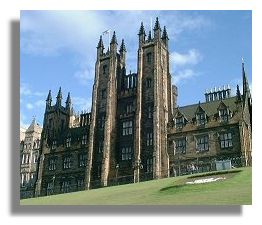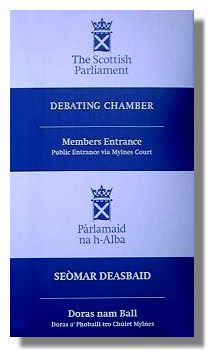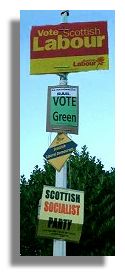Background
In UK elections since the Second World War, Scotland has returned a majority of Labour Members to the UK Parliament. Each of 72 constituencies are elected on the basis of the candidate with the largest number of votes for each seat - known here as the "First Past the Post" (FPTP) system. Thus, from 1974 onwards, the United Kingdom election results in Scotland showed:
| Election | Labour | Conservative | Liberal Democrat | Scottish Nationalists |
|---|---|---|---|---|
| Feb 1974 | ||||
| Oct 1974 | ||||
| May 1979 | ||||
| June 1983 | ||||
| June 1987 | ||||
| Apr 1992 | ||||
| May 1997 |
 As can be seen, Labour MPs in Scotland have accounted for over 50% of those elected to the UK Parliament in London. So when the prospect was raised again in the 1990s of a devolved Scottish Parliament in Edinburgh, to look after local issues, it was clear that if the UK electoral system was adopted, Labour would invariably have a majority. While having decades of a Labour government might have suited some Labour Party activists, such an outcome would not have gained the support of other political parties for a Scottish Parliament - and that support was seen as being essential if a devolved legislature was to become a reality. In addition, it would have been more difficult to win a clear majority in favour of a devolved parliament if it was seen that one party would dominate that parliament for years to come.
As can be seen, Labour MPs in Scotland have accounted for over 50% of those elected to the UK Parliament in London. So when the prospect was raised again in the 1990s of a devolved Scottish Parliament in Edinburgh, to look after local issues, it was clear that if the UK electoral system was adopted, Labour would invariably have a majority. While having decades of a Labour government might have suited some Labour Party activists, such an outcome would not have gained the support of other political parties for a Scottish Parliament - and that support was seen as being essential if a devolved legislature was to become a reality. In addition, it would have been more difficult to win a clear majority in favour of a devolved parliament if it was seen that one party would dominate that parliament for years to come.
Donald Dewar, the leader of the Labour Party in Scotland was a shrewd politicians - and a lawyer. He proposed a system which was a mixture of the UK "first past the post" (FPTP) sytem for the 73 constituencies (mirroring those for the UK parliament but with the Orkney and Shetland islands split into two seats for the Scottish Parliament), plus another 56 seats elected under what is called the "Additional Member System" (AMS) which is a form of proportional representation (PR). While this still gave his party a strong position as a result of the FPTP element, the hybrid system also meant that one party was less likely to be in overall control.
The Additional Member System
The "Additional Member System" gives each voter a second vote for a political party (or for a candidate standing as an individual), within a larger electoral area called a Scottish Parliament Region. There are 8 Scottish Parliament Regions. Each region has 7 additional seats in the Parliament. The members chosen to fill these 56 additional seats are known as "Regional Members" to distinguish them from those elected in the 73 constituencies.
 The way in which the Regional Members are actually elected using the second vote is quite complex:
The way in which the Regional Members are actually elected using the second vote is quite complex:
- Each of the main parties first of all select (usually by votes cast by party members in advance of the election) a "Regional List" of up to 12 candidates.
- These candidates are listed on the ballot paper (Yes, the ballot paper is very long!). Independent candidates are also listed individually.
- Voters can select one of the individual candidates or a party. They can select the same party as their first vote or a different one. (It is estimated that in 1999, 80% of voters selected the same party as the one they chose in the first vote).
- Once the number of constituency seats won by each party under the vote is known, the number of votes cast for each party under the second vote in a region is divided by the number of these constituency seats - plus one.
- Thus a party with a large number of constituency seats in a region will have a large denominator, while those parties with a smaller numbers of constituency seats but a good number of second votes will have a much smaller denominator. For example, if Party A has 9 constituency seats in a region and 200,000 votes on the second ballot paper, the 9+1 is divided into 200,000 (giving 20,000). Party B, which has a good number of second votes, say 150,000, but no constituency seats has that 150,000 divided by just 1 - and would gain the first Regional seat. In the second round, Party B's 150,000 votes are this time divided by 2 - so winning another Regional seat. This process is continued (with the divisor increased by one each time) until all the Regional seats are allocated.
- It is estimated that a party or individual with at least 5 to 7% of the second votes will win a Regional seat. It is for that reason that even independent candidates have a chance of winning a Regional seat.
The Result in 1999
 The number of constituency seats won under the First Past the Post election and the number won under the Additional Member System in 1999 were:
The number of constituency seats won under the First Past the Post election and the number won under the Additional Member System in 1999 were:
Seats | Seats | ||
| Labour | |||
| Liberal Democrats | |||
| Scottish Nationalist | |||
| Conservative | |||
| Independent |
The "Independent" seats in the 1999 election were won by a member of the Green Party, a member of the Scottish Socialist Party and a true "independent" (a former member of the Labour Party).
Since no single party had a majority of the total seats, Labour and the Liberal Democrats formed a coalition government. Two Liberal Democrats were allocated cabinet posts in the Scottish Executive and the two parties agreed joint policies.
May 2003 Election
On 1 May 2003 all the seats in the Scottish Parliament will be contested again. This time, there is an even larger number of small parties and individuals hoping to win the Regional seats under the Additional Member System. Some are true "independents", others are fighting on specific issues eg fishermen who are unhappy with the European quota system for catching fish. It certainly makes for a more varied and colourful election!
More Information
You can get more information on the UK and Scottish electoral system and the political parties from the following sites:
- Scottish Parliament - Yesterday and Today
- Scottish Parliament Web Site
- UK Parliament Web Site
- BBC Guide to UK Parliament
- Scottish Labour Party
- Scottish Liberal Democrat Party
- Scottish National Party
- Scottish Conservative and Unionist Party
- Scottish Green Party
- Scottish Socialist Party
- Scottish Independence Party
- People's Alliance Party




